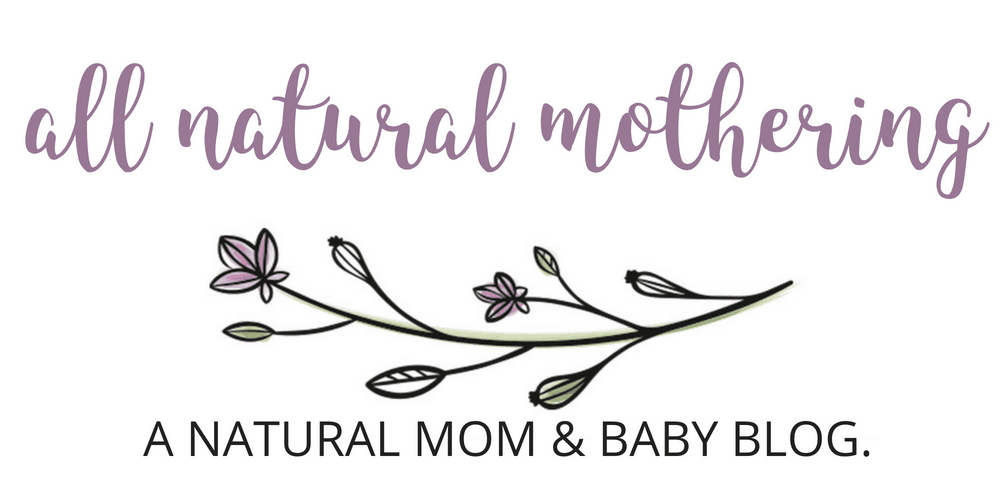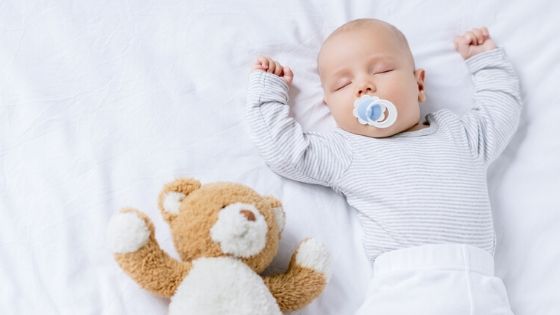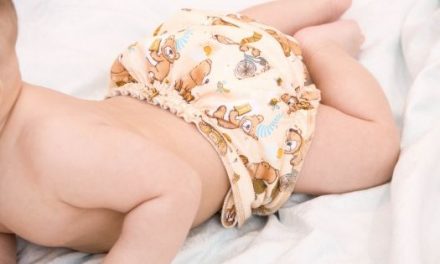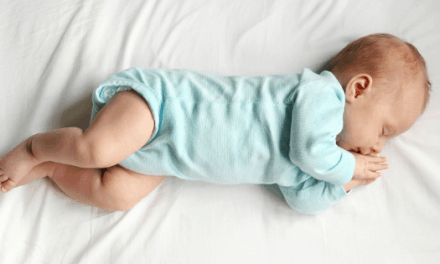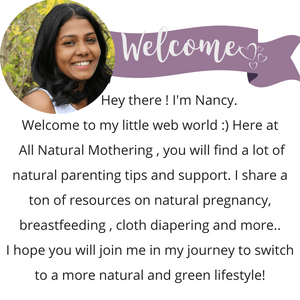Deciding to use a pacifier with your baby can be a tricky decision, and learning about pacifier alternatives for babies and toddlers can help.
For some mamas, pacifiers provide a break they desperately need when they have a baby whose colicky or having a particularly fussy day.
It can also be a way to help baby learn to self-soothe and satisfy their sucking reflex.
What?s more, giving a pacifier at the onset of a sleep session can reduce your baby’s risk of SIDS and is actually recommended by the AAP and other experts (source).
However, even with all of these potential benefits, you want to approach the use of pacifiers with caution.
They should never be used to delay a feeding and shouldn’t be introduced until breastfeeding is well-established.
They are associate with ear infections and potential teeth and speech issues as well.
Beyond this, you want to consider the challenges of eventually weaning your little one from their pacifier before it’s too late.
With all of this in mind, let’s talk about pacifier alternatives.
Knowing how to soothe babies without a pacifier may help you avoid pacifier use.
We’ll also talk about pacifier alternatives for toddlers to help you get through the challenging phase of kicking the pacifier habit for good.
When to stop using pacifiers
I mentioned in the introduction that pacifier use in babies is actually recommended by the AAP to reduce the risk of SIDS.
However, it’s important not to let pacifier use continue for too long.
Between 6 and 12 months is the ideal time to start weaning your baby off of their pacifier.
It’s not necessary to discontinue use entirely, but beginning to reduce the use to sleep times only will make removing it completely easier later on.
The reason is because around 6 months, pacifier use begins to be associated with recurring ear infections.
One study done by a team of pediatricians in Finland found that limiting pacifier use can reduce the number of infections by 29% (source).
By the time your little one is 2 years old, it’s time to wean them off of their pacifier completely.
At this point, pacifier use may be associated with dental and speech problems, which we’ll discuss more in detail below.
Why should you stop pacifiers?
Now you know pacifier use should be greatly reduced between 6 and 12 months, and stopped completely around their second birthday. But let’s dig more into why you should stop using pacifiers.
Teeth development
It is largely thought that extended pacifier use will negatively affect your child’s teeth. The thing is, pediatric dentists actually say this isn’t true– of baby teeth anyway.
Within a few months of not using a pacifier, your child’s baby teeth will shift back to normal (source).
The concern is that pacifier use can permanently damage adult teeth if they are still being used when adult teeth come in. This can be as early as 4-6 years old for some children.
Specifically, pacifier use in 3 to 5 year olds has been associated with an anterior open bite, posterior crossbite, mean overjet, and more (source).
For these reasons, stopping pacifier use between 2 and 3 years is essential to decreasing the risk of permanent teeth damage due to a lingering habit when your child does start losing their baby teeth.
And in any case, it’s a good idea to mention your child’s pacifier use (or finger sucking!) to their dentist to make them aware.
Speech development
Extended pacifier use may alter your child’s speech development and cause speech delays.
While there is indisputable research linking pacifier use to teeth development issues and ear infections, the research on speech isn’t as clear.
This is because many research studies don’t take into consideration the amount of time the pacifier is used in each day (source).
However, most speech and language pathologists recommend stopping pacifier use between 12-18 months, because this is when language really starts to take off.
The recommendation is mostly in order to give your baby more opportunity to imitate noises and sounds and practice talking. Having a pacifier in their mouth can obstruct or discourage these opportunities (source).
Ear infections
It is widely accepted that pacifier use may exacerbate ear infections in babies based on a number of research studies.
Some studies suggest that your baby is three times more likely to get ear infections if they use a pacifier (source).
If your baby is experiencing recurring ear infections and uses a pacifier it could definitely be a contributing factor.
What’s interesting is that the frequency of pacifier use does increase the risk.
Occasionally using a pacifier is not associated with ear infection increase, but regular users are at a higher risk (source).
(Possible) Nipple Confusion
Nipple confusion and pacifier use is a bit controversial.
This is because there is a lot of mixed and misinformation out there on the topic (source).
Remember earlier in this article that the AAP actually recommends pacifier use to reduce the risk of SIDS in babies under 6 months.
But this same organization, along with the World Health Organization and La Leche League, discourage the use of artificial teats until breastfeeding is well established.
So which is it?
The belief behind nipple confusion stems from the idea that the muscles babies use to extract milk from the breast are different than the muscles used on a bottle or pacifier.
The fear is that by using an artificial nipple too early, baby will be inefficient at nursing.
What’s more, when pacifiers are used to delay feedings or bottles are given too early, it can effect mama’s growing milk supply.
Whether this is all true or not, experts largely recommend holding off on pacifier use for breastfed babies for the first 3-4 weeks minimum, ideally until 6-8 weeks when nursing is typically well-established and going well (source).
To be clear, possible nipple confusion isn’t a reason to stop pacifier use in older babies, but more about delaying the start of pacifier use, or stopping if you have an infant younger than 6 weeks.
Giving up the pacifier is often harder the longer you wait
If you’ve spent any time around a 2-year-old, you know that they can be far more defiant than a 6-12 month old. So kicking the habit earlier is a benefit for that reason too!
Many toddlers become very dependent on their pacifiers to sleep and cope with frustrating emotions. The sooner you help them find alternatives to pacifier use, the easier the transition will be.
Below we’ll give you tips specific to pacifier alternatives for toddlers.
Pacifier Alternatives for babies
We’ve covered why you’d want to find pacifier alternatives for babies and when to stop pacifier use, now let’s talk about the alternatives!
First, we’ll understand why babies like pacifiers in the first place.
With this understanding in place the alternative ways to soothe babies without a pacifier will be clearer.
Why Do Babies like Pacifiers?
Even with the potential risks, there is no doubt that pacifiers work and their use is common.
In fact, it is estimated that 75-80% of babies in Western countries use a pacifier (source).
Why are they so effective?
Suck reflux:
Babies are born with the reflex to suck, and it is considered to be one of the main 5 S womb sensations associated with calming a baby (source).
When babies suck it lowers their heart rate, blood pressure and stress levels.
We know that babies begin sucking on their thumbs and hands in the womb, and their need to suck continues after they are born. Yes, for nutrients, but also as a means to soothe themselves.
Soothing:
Because sucking is so soothing for babies, Dr. Harvey Carp renowned author of Happiest Baby on the Block, is a huge proponent of pacifiers and says you can’t let a baby suck too much in the first few months. It’s something they innately need to do in order to be soothed (source)
Security:
As your baby grows they will come to associate their pacifier sucking with calmness which gives them a sense of security. Before you know it, your baby may become quite attached to their pacifier as a means of feeling soothed.
How to Soothe Babies without a pacifier?Whether you want to avoid pacifier use altogether, your baby won’t take a pacifier, or you’re trying to wean your baby off the pacifier, here are some great suggestions on how to soothe you baby without one.
1. Breastfeeding
If you are breastfeeding your baby, this will become one of your best tools for calming your baby.
Of course, breastfeeding provides your baby with the nutrients and hydration they need to grow and develop, but one often overlooked purpose of nursing, is to provide comfort.
Too often popular culture shames mamas who allow their babies to nurse for comfort or use them as a pacifier but that’s exactly what nursing is designed to do!
This has been proven in a research study that showed breastfeeding as the most effective tool for soothing a baby after receiving a heel prick over any other method (source).
So go ahead and enjoy those sweet snuggles and soothe your baby with what nature gave you 😉
2. Rocking & Bouncing
Earlier, I mentioned Dr. Harvey Carp. His research surrounds soothing babies in their first three months of life. He discusses the 4th trimester in depth and talks about the 5 s’s. One of which, is sucking, but swinging is another (source).
By this he means any movement. Rocking, bouncing and swaying your baby can be highly effective ways to soothe them.
Gliders are popular, bouncing or walking with your baby while wearing them, and even bouncing them on a yoga ball are all effective way to use movement to soothe your fussy baby instead of a pacifier. Wearing my babies using a wrap (like this one) and walking worked like a charm to calm my babies.
3. White Noise
While babies are in the womb, it’s anything but quiet.
In fact, it probably sounds a lot like white noise. For this reason, making a shushing noise while you comfort your baby can be highly effective. To keep them calm, a white noise machine can function the same way.
When my infant is having long fussy periods and during the witching hour, I often take him into a darkened room, turn on white noise, swaddle him tight and bounce him on a yoga ball. This combo effectively calms him almost every time.
4. Teething toys
Often, babies need extra soothing when they are teething.
Additionally, babies use their mouths to explore and learn more about the world. Offering teething toys and chew toys can be very soothing in these instances.
Be sure to pick toys made of natural materials like silicone or wood instead of potentially toxic plastics. This one is great for very young babies.
Teething toys that can be frozen or that you can add frozen breastmilk to can have a particularly calming and soothing effect on sore gums.
Pacifier Alternatives for toddlers
The next five suggestions are especially helpful for toddlers when you are weaning them off their pacifier.
5. Blanket
Earlier, we talked about how pacifiers can give little ones a sense of security. You may be able to help your toddler transition from a pacifier for soothing to a security to a blanket.
To help them attach to a blanket instead, spend time cuddling and reading books with the blanket.
Always keep the blanket with you during your bedtime and naptime routine, and pull it out when you’re comforting your child when they are upset.
Soon, they will start to associate the blanket with a sense of security.
6. Cuddle buddy or Lovey (soft toy)
Similarly to a blanket for soothing, you may be able to help your toddler attach to a cuddle buddy, stuffed animal, or other lovey for a sense of security instead of their pacifier. Use the same strategies suggested above to help them attach.
7. Night light
If taking away the pacifier during sleep times has your toddler feeling scared or upset, a nightlight can be helpful for soothing them.
This might be a simple plug-in one, or one that displays a pretty pattern on the ceiling. Involve your toddler in choosing a special new nightlight for their room and they may be more receptive to it as a means to calm down.
This particular night light doubles as a sound machine and a night light, plus it grows with your baby and is very comforting for toddlers.
8. New Toy
When it comes to taking away a pacifier, giving your toddler a new toy might make the transition smoother. Having a new toy to look forward to incentivizes them to go without the pacifier and find other ways to soothe themselves.
9. Using a straw
If your toddler has been using a pacifier for a while, they undoubtedly find the sucking motion to be soothing and comforting. Using a straw (try this)to drink water may fulfill their desire to suck without using a pacifier.
Letting your older toddler go to bed with a spill-proof straw cup of water might just do the trick.
10. Breaking the suction
To help your toddler kick their pacifier habit, you can make an incision in the pacifier teat. This breaks the suction power and helps the pacifier lose its appeal for many little ones.
11. Passing on the pacifier:
Lastly, if you have an older or more mature toddler you can try a technique of passing on the pacifier.
Get your toddler excited about being a big kid who doesn’t need pacifiers any more. Have them pass the pacifier on to a new baby joining your family, a cousin, or neighbor’s baby.
Final Word:
There are lots of pacifier alternatives for babies, newborns and toddlers!
Well mama, no matter what your situation is, you’re now equipped with a number of solid ways to soothe your baby without a pacifier.
With an infant, keep the 5 s’s in mind and don’t be afraid to nurse your baby for comfort.
For an older baby, try rocking, white noise or offering teething toys.
And with a toddler, your goal is to replace their pacifier with another security object or help them feel like a big kid that doesn’t need a pacifier anymore.
Keep that baby calm mama, and carry on!
